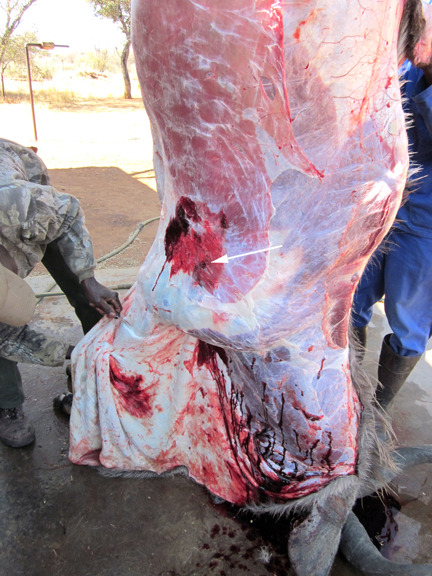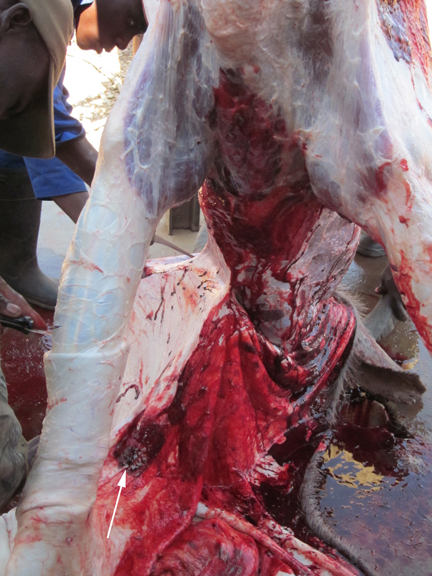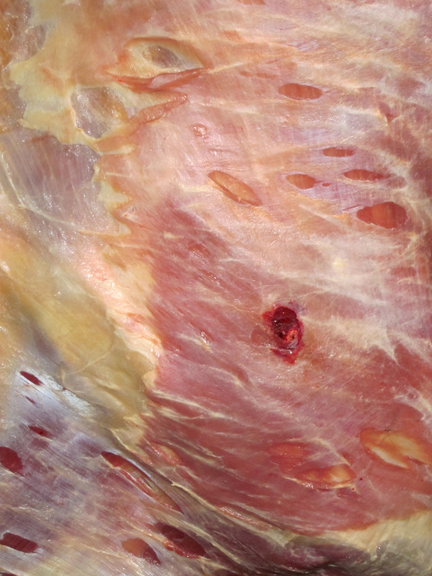
BIG & SLOW vs SMALL & FAST:
MORE
ON THE SUBJECT OF MEAT DAMAGE
A version of this essay appears in Magnum magazine
There's a perennial debate on what is the "best" caliber for big game, and in the minds of most American hunters, "faster = better," and don't you ever forget it. The American obsession with bullet velocity is taken as Gospel by the various hunting magazines in the USA, and manufacturers are always bringing out "new" calibers, heavily touted as "better" because they move a bullet faster.
The formulae for calculating "muzzle energy" are such that a fairly small increase in speed translates into a large increase in kinetic energy: the energy is in proportion to the square of the velocity.
But a much better measure of the effectiveness of the bullet is its momentum: that tells you how likely it is to penetrate deeply and in a straight path. Momentum and deep penetration are more important in killing effectiveness than velocity, and every PH in Africa understands this principle. Big, strongly constructed bullets moving at moderate speeds are what they prefer, and while most of these pros would never criticize a client's choice, they cringe when someone shows up with a rifle firing some Super-Mangle-Em cartridge shooting bullets not much bigger than a phonograph needle.
Having recently returned from a safari in Namibia, accompanied by my regular hunting partner Art and his son, Matthew, I present for the readers of this site an example that I think is pretty convincing.
Matthew has long hunted in the USA, and accepts as Holy Writ the notion that high velocity and high paper energy figures are the most important factors in a rifle’s effectiveness. So for his very first safari, for plains game, he was using a rifle chamberd for the .300 Remington Ultra Mag caliber. Art, who has a good deal of African hunting experience, but not much in North America, used his .416 Remington.
Matt’s powerhouse was loaded with 200 grain Swift A-Frame bullets: muzzle velocity of 3032 FPS and muzzle energy of 4083 foot pounds. Art’s .416 used a 400-grain bullet at a comparatively plodding 2400 FPS and 5115 foot pounds of energy. The momentum for the .300 RUM bullet (mass x velocity) is 86.6 F-P; for the .416 it is 137 F-P.
Matt shot a very large old kudu bull with his .300 RUM in the neck. The first image presented here shows the entry wound from his bullet. The arrow points to the actual bullet hole. The kudu was shot at the top of the neck: the entry wound has extensive blood-shot meat.

When the skinners removed the cape, the very large blood shot area on the underside of the neck was obvious. The arrow indicates the exit point of the bullet in the image below.

Art shot a big zebra stallion through the heart and lungs with his .416: this last image shows the exit wound from his soft-pointed bullet, a 400-grain .416 Hornady DGX: there is virtually no meat loss.

Both animals were approximately the same size; both were killed with one shot, at comparable ranges of 40 yards or so. In both cases the bullet passed completely through. Both animals were equally dead, but if there is a more vivid visual comparison of the levels of meat damage done by the “light and fast” versus the “slow and heavy” concepts I have yet to see it. The entry wound from the .300 RUM shows significant amounts of blood shot meat; the exit wound on the underside of the neck is simply a jelly-like mass with extensive areas of damage. But as the old saying goes, on Art’s zebra, you could “eat right up to the hole.”
My vote goes to “big and slow!”
| HUNTING | GUNS | DOGS |
| FISHING & BOATING | TRIP REPORTS | MISCELLANEOUS ESSAYS |
| CONTRIBUTIONS FROM OTHER WRITERS|
| RECIPES |POLITICS |